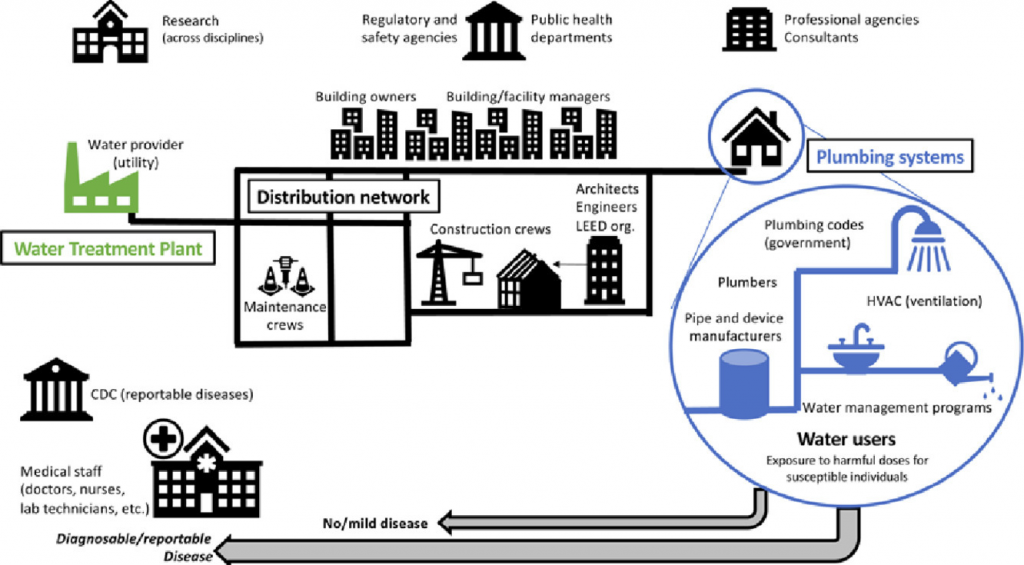
Hi all…the existence of opportunistic pathogens in drinking water distribution systems and premise plumbing (DWPI) has been known for decades. Attention has been focused primarily on Legionella but owing to a variety of factors, solutions are a patchwork at best. Below are two recent papers on the topic.
- The first has just been published in the journal ‘Water Research’ asking the question “how can all microorganisms of concern in drinking water distribution systems and premise plumbing be managed simultaneously?” They conclude “while a single solution that creates a “zero-risk” plumbing system is not possible, increased cooperation and multiple DWPI consideration will allow for informed balancing of risk and consequences.” The full abstract is below.
- A second very relevant paper entitled “Legionella and other opportunistic pathogens in full-scale chloraminated municipal drinking water distribution systems” was published earlier this fall. It “aimed to quantify how physicochemical parameters, mainly monochloramine residual concentration, hydraulic residence time (HRT), and seasonality, affected the occurrence and concentrations of four common opportunistic pathogens (OPs) (Legionella, Mycobacterium, Pseudomonas, and an amoeba [I am not familiar with] Vermamoeba vermiformis) in four full-scale DWDSs in the US. Legionella as a dominant OP occurred in 93.8% of the 64 sampling events and had a mean density of 4.27 × 105 genome copies per liter. Legionella positively correlated with Mycobacterium, Pseudomonas, and total bacteria. Multiple regression with data from the four DWDSs showed that Legionella had significant correlations with total chlorine residual level, free ammonia concentration, and trihalomethane concentration. They concluded that Legionella is a promising indicator of water-based OPs, reflecting microbial water quality in chloraminated DWDS.” While this remains to be confirmed in other systems, it is a promising development. I have not reproduced the abstract for this one, it is available at https://doi.org/10.1016/j.watres.2021.117571.
Bill________________________________________________________
Tenets of a Holistic Approach to Drinking Water-Associated Pathogen Research, Management, and Communication
Caitlin Proctor, Emily Garner, Kerry A. Hamilton, Nicholas J. Ashbolt, Lindsay J. Caverly, Joseph O. Falkinham III, Charles N. Haas, Michele Prevost, Rebecca Prevots, Amy Pruden, Lutgarde Raski, Janet Stout, Sarah-Jane Haig
Water Research (2021), doi: https://doi.org/10.1016/j.watres.2021.117997
ABSTRACT
“In recent years, drinking water-associated pathogens that can cause infections in immunocompromised or otherwise susceptible individuals (henceforth referred to as DWPI), sometimes referred to as opportunistic pathogens or opportunistic premise plumbing pathogens, have received considerable attention. DWPI research has largely been conducted by experts focusing on specific microorganisms or within silos of expertise. The resulting mitigation approaches optimized for a single microorganism may have unintended consequences and trade-offs for other DWPI or other interests (e.g., energy costs and conservation). For example, the ecological and epidemiological issues characteristic of Legionella pneumophila diverge from those relevant for Mycobacterium avium and other nontuberculous mycobacteria. Recent advances in understanding DWPI as part of a complex microbial ecosystem inhabiting drinking water systems continues to reveal additional challenges: namely, how can all microorganisms of concern be managed simultaneously? In order to protect public health, we must take a more holistic approach in all aspects of the field, including basic research, monitoring methods, risk-based mitigation techniques, and policy. A holistic approach will (i) target multiple microorganisms simultaneously, (ii) involve experts across several disciplines, and (iii) communicate results across disciplines and more broadly, proactively addressing source water-to-customer system management.”





